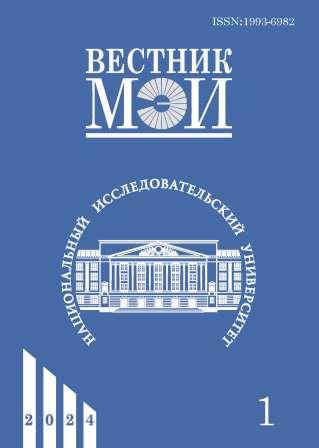Применение методов системного анализа и искусственного интеллекта для диагностики состояния динамического объекта на примере органа зрения. Ч. 2
Аннотация
Работа связана с проблематикой конструирования перспективных систем поддержки принятия решений для помощи специалистам при диагностике состояний динамических объектов на примере задачи медицинской диагностики (ранней диагностике патологий сетчатки глаза). Для диагностики предложено применение интегрированного подхода на основе методов системного анализа и методов искусственного интеллекта (нечетких множеств, когнитивной графики). Исследования и разработки выполнены совместно специалистами НИУ «МЭИ» (кафедры прикладной математики и искусственного интеллекта (ПМИИ) и управления и интеллектуальных технологий (УИТ) и физиологами ФГБУ «НМИЦ глазных болезней им. Г. Гельмгольца» (отдел клинической физиологии зрения им. С.В. Кравкова). В первой части [1] рассмотрены проблема ранней диагностики патологий сетчатки глаза, предварительная обработка информации с применением вейвлет преобразований, применение амплитудно- и фазочастотных преобразований электроретинограмм (ЭРГ) для расширения признакового пространства. Обоснована целесообразность интеграции методов системного анализа и искусственного интеллекта для решения задачи ранней диагностики и анализа процесса развития патологий сетчатки. Показана важная роль методов системного анализа как для предварительной обработки информации, так и для собственно диагностики.
Во второй части представлена методика ранней диагностики патологий сетчатки с применением методов системного анализа и нечеткой логики с целью определения диапазонов признаков, характеризующих конкретные патологии, и сопоставления их с диапазоном признаков для нормального зрения. Предложен аппарат когнитивной графики (когнитивных образов) для создания визуальных образов, отражающих структурные особенности сетчатки глаза и его способность воспринимать тестирующие воздействия.
Литература
2. Zueva M.V. e. a. Assessment of the Amplitude-frequency Characteristics of the Retina with Its Stimulation by Flicker and Chess Pattern-reversed Incentives and their Use to Obtain New Formalized Signs of Retinal Pathologies // Biomedical J. Sci. &Techn. Research. 2019. V. 19(5). Pp. 14575—14583.
3. Кофман А. Введение в теорию нечетких множеств. М.: Радио и связь, 1982.
4. Нечеткие множества в моделях управления и искусственного интеллекта / под ред. Д.А. Поспелова. М.: Наука, 1986.
5. Еремеев А.П., Колосов О.С., Зуева М.В., Цапенко И.В. Интеграция методов системного анализа и когнитивной графики при ранней диагностике патологий зрения // Труды ХХ Национ. конф. по искусственному интеллекту с междунар. участием. Т. 2. М.: Изд-во МЭИ, 2022. С. 313—329.
6. Robson A.G. e. a. ISCEV Standard for Full-field Clinical Electroretinography // Documenta Ophthalmologica. 2022. V. 144(3). Pp. 165—177.
7. Robson A.G. e. a. ISCEV Guide to Visual Electrodiagnostic Procedures // Documenta Ophthalmologica. 2018. V. 136(1). Pp. 1—26.
8. Özbay Y., Ceylan R., Karlik B. Integration of Type-2 Fuzzy Clustering and Wavelet Transform in a Neural Network Based ECG Classifier // Expert Syst. with Appl. 2011. V. 38(1). Pр. 1004—1010.
9. Brynolfsson J., Sandsten M. Classification of One-dimensional Non-stationary Signals Using the Wigner-Ville Distribution in Convolutional Neural Networks // Proc. XXV European Signal Conf. Kos, 2017. Pp. 326—330.
---
Для цитирования: Еремеев А.П., Колосов О.С., Зуева М.В., Цапенко И.В. Применение методов системного анализа и искусственного интеллекта для диагностики состояния динамического объекта на примере органа зрения. Ч. 2 // Вестник МЭИ. 2024. № 1. С. 128—137. DOI: 10.24160/1993-6982-2024-1-128-137
#
1. Eremeev A.P., Kolosov O.S., Zueva M.V., Tsapenko I.V. Primenenie Metodov Sistemnogo Analiza i Iskusstvennogo Intellekta dlya Diagnostiki Sostoyaniya Dinamicheskogo Ob'ekta na Primere Organa Zreniya. Ch. 1. Vestnik MEI. 2023;6:135—143. (in Russian).
2. Zueva M.V. e. a. Assessment of the Amplitude-frequency Characteristics of the Retina with Its Stimulation by Flicker and Chess Pattern-reversed Incentives and their Use to Obtain New Formalized Signs of Retinal Pathologies. Biomedical J. Sci. &Techn. Research. 2019;19(5):14575—14583.
3. Kofman A. Vvedenie v Teoriyu Nechetkikh Mnozhestv. M.: Radio i Svyaz', 1982. (in Russian).
4. Nechetkie Mnozhestva v Modelyakh Upravleniya i Iskusstvennogo Intellekta. Pod Red. D.A. Pospelova. M.: Nauka, 1986. (in Russian).
5. Eremeev A.P., Kolosov O.S., Zueva M.V., Tsapenko I.V. Integratsiya Metodov Sistemnogo Analiza i Kognitivnoy Grafiki pri Ranney Diagnostike Patologiy Zreniya. Trudy XX Natsion. Konf. po Iskusstvennomu Intellektu s Mezhdunar. Uchastiem. T. 2. M.: Izd-vo MEI, 2022:313—329. (in Russian).
6. Robson A.G. e. a. ISCEV Standard for Full-field Clinical Electroretinography. Documenta Ophthalmologica. 2022;144(3):165—177.
7. Robson A.G. e. a. ISCEV Guide to Visual Electrodiagnostic Procedures. Documenta Ophthalmologica. 2018;136(1):1—26.
8. Özbay Y., Ceylan R., Karlik B. Integration of Type-2 Fuzzy Clustering and Wavelet Transform in a Neural Network Based ECG Classifier. Expert Syst. with Appl. 2011;38(1):1004—1010.
9. Brynolfsson J., Sandsten M. Classification of One-dimensional Non-stationary Signals Using the Wigner-Ville Distribution in Convolutional Neural Networks. Proc. XXV European Signal Conf. Kos, 2017:326—330
---
For citation: Eremeev A.P., Kolosov O.S., Zueva M.V., Tsapenko I.V. Application of System Analysis and Artificial Intelligence Methods to Diagnose the State of a Dynamic Object Taking the Retina as an Example. Part 2. Bulletin of MPEI. 2024;1:128—137. (in Russian). DOI: 10.24160/1993-6982-2024-1-128-137




